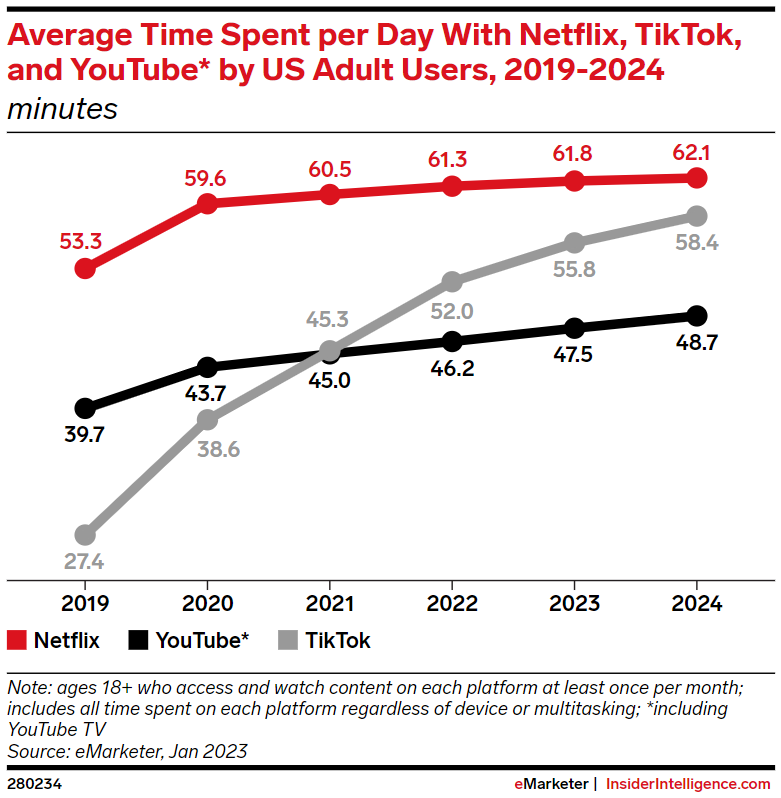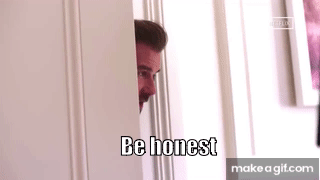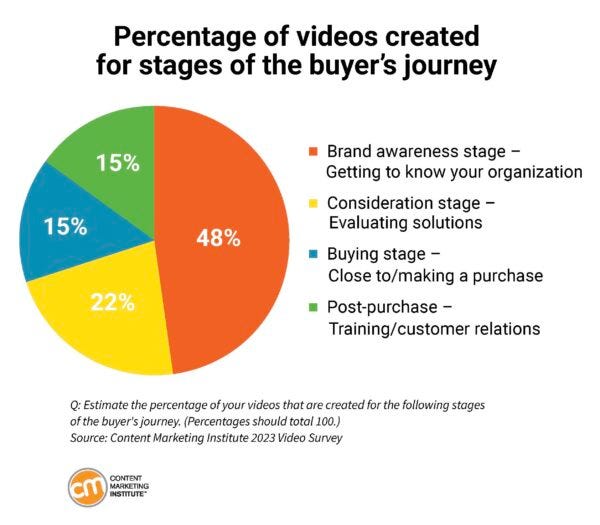📺 Video content is completely changing marketing (again)
3 out of 4 marketing managers want to invest more in video content. Why are so many brands drawn to it? And what 5 steps does successful green video marketing need?
Hi 👋 I’m Florian Schleicher. This is the FutureStrategies newsletter of FUTURES. Thank you so much for reading along 💚 If you want to learn strategic marketing from me, then my Simple & Sustainable Marketing Academy is the perfect fit for you.
If you work in marketing, it's not easy.
Imagine you're alone on a train. What do you do?
Most people pull out their cell phones. A short video can provide a refreshing break and pass the time.
No sooner have most marketing managers understood how we can properly use social media platforms for our brand messages than the market evolves again and more and more often I hear from customers how tireless they have to be to keep up.
YouTube has been around for a long time, but for the most part, it wasn't a big change for companies to provide content there - and I know of only a few brands that were able to use the platform to achieve their goals. Only a few users actively followed brands on YouTube and therefore the channel was neglected by many.
Curtain up for TikTok:
“The 2010s were the era of Instagram, which was all about curation. Now we’ve replaced that with TikTok, which is self-shot, messy video content, feeding our desire for 24 hours of newness. We’ll see more of this in the future and also recycling content, seeing the idea of appropriating content for memes, remixing it, bringing new life to archive footage."
Bunny Kinney, Creative Director, NOWNESS
And suddenly marketing managers are faced with the next challenge.
In 2021, TikTok was already the most visited website in the world, attracting more attention than Facebook and TikTok combined.
Facebook connects. TikTok entertains.
And nothing beats entertainment.
That's why TikTok is well on its way to overtaking Netflix.
YouTube has been left behind since 2021.
However, only 7% of all marketing managers say that they use the full potential of videos in corporate communications.
So today we take a look:
Why are (short) videos capturing our attention?
What is the biggest challenge for companies?
How can sustainable brands and products capitalize on this trend?
🤩 Why short videos are capturing our attention
A long day at work. Finally arrived on the couch after training.
Cell phone in hand, TikTok is opened straight away.
Just a few minutes to unwind and relax.
And then 30 minutes pass.
Who doesn't know that? Be it Instagram, YouTube, or TikTok. Many of us prefer to get short moments of relaxation in the form of videos.
Our brains can process videos up to 60,000 times faster than text - that's why we love them.
Videos can tell stories better, more intensively, and more emotionally than images and text. This makes them an ideal format, especially in times of dwindling attention - also in marketing. Studies show that a short video attracts users even more easily than a longer video.
According to the YouTube Culture & Trends Report, 90% of Gen Z watch videos to mentally transport themselves to another place. And 83% watch video content to relax.
We all have stress in our everyday lives and then reaching for a book seems like too much effort. We seek instant gratification, that is, immediate satisfaction of our need for relaxation. At a time when our average attention span is 8 seconds or less, we are looking for the shortest route to perceived happiness.
And that is precisely the promise of TikTok and Instagram Reels: instant entertainment and relaxation.
Short videos are so popular because very few of us think, "Now I'm going to spend an hour watching random videos of people (or cats in my case) I don't know and who are in completely different life situations."
What we think is: "Just relaxing for a moment."
“Videos on TikTok and YouTube Shorts engage users through short bursts of thrills which can lead to the development of addictive behavior.”
Guizhou University of Finance and Economics in China and Western Michigan University
TikTok is not only successful because the platform focuses on short videos.
But also because they have developed their very own algorithm. Most users do not follow their friends or large accounts but are entertained by the extremely sophisticated algorithm on the For-You page, which recognizes very (frighteningly) quickly what we want to see.
And if the content is really good, we share it: 92% of all consumers share videos with others - that's 1200% more shared videos than images and texts combined.
Short videos are a bit like a casino, a kind of drug.
All popular video platforms work on the same principle as a slot machine: Once you start, it's really hard to stop because our brains are so focused on quick gratification.
This creates an addiction to short videos that release dopamine in the brain. Dopamine makes us do things that satisfy us. The more pleasure you want to feel, the higher your addiction potential.
One quick example before we get to marketing:
Short videos make you feel good while you watch them, which forces people to keep returning to the platforms and seeking another video that brings them joy. That is what most short video companies want you to do. Videos about puppies, cats, and funny videos are popular because they give people a sense of pleasure and encourage them to return.
Anyone who feels caught out now: I'm no different. I'm currently trying to "re-educate" myself with other activities - sometimes it works better, sometimes worse.
But now that we understand what videos do to people, we can identify key learning - no matter what we think of videos and short videos:
If we don't embed video as an action in our marketing strategy, we're missing out on a lot of potential consumers!
💛 What is the biggest challenge for companies?
Forty-three percent of marketers surveyed say videos can create a human connection by telling stories, struggles, and triumphs. A third (35%) say videos can inform by showcasing products and services, while 20% believe videos can help educate audiences.
Many companies are seeing the trend.
So, why aren't all brands taking advantage of the potential of video?
67% of marketers say video has become more important to the business over the last year. Yet only 7% say they use it to its full potential.
Because it's not just any videos that work particularly well.
Consumers prefer low-quality videos that are authentic, whereas high-quality videos that are artificial or inauthentic are unpopular.
This is a problem for many companies and brands.
Because their marketing is often not authentic.
In a world where polished commercials and thoughtful campaigns are the norm, popular short-form videos require a more raw, direct approach that is often outside the comfort zone of many brands.
TikTok's young and interactive audience wants content that is entertaining, thought-provoking, and has a real human element - far removed from the usual sales messages.
“TikTok is camera-in-hand, selfie-mode, face-forward staring at the audience, where spontaneity is key.”
It seems counterintuitive for many brands to simply reach for their cell phones and quickly record a video. But that's exactly what consumers want to see on Instagram or TikTok (or YouTube Shorts).
23% of Gen Z consider authenticity to be important, more than almost any other product or company attribute such as design or social impact.
22% of Gen Z find that a lack of transparency detracts from their opinion of brands and products, more than any other generation.
It's all about behind-the-scenes impressions, a shaky camera, a slip of the tongue, and unvarnished insights. The nightmare of many marketing departments.
If brands can't do this themselves, then it's good to get an outside perspective that shows how this can work.
Some companies are even experimenting with letting users produce content for them:
“The quality and authenticity of user-generated content is likely higher than more polished, sponsor-y content from professional influencers. Sure, some of it might be garbage, but some of it might be gold. And brands are paying on a CPM basis—in other words, they only pay for content that performs well.”
Rex Woodbury
Achieving this authenticity requires a deep understanding of platform culture and often a willingness to take risks and loosen traditional brand guidelines. Many brands struggle to strike the right tone and connect authentically with a community that values quick, authentic content that fits seamlessly into their daily feed.
Do you want to make your marketing authentic and achieve your goals?
I help many marketing managers with exactly these kinds of challenges.
Simply contact me directly here or take a look at who we work for.
The majority of companies and brands use videos in the attention stage of their marketing funnel. In other words, to tell consumers that they exist.
But TikTok and Instagram can also have a major effect on the purchasing process:
Over 50% of all consumers say they have bought directly from a brand they recently discovered on social media. This puts both platforms well above the other networks.
TikTok is even ahead of Instagram when it comes to impulse purchases. According to StyleSeat, more than half (55%) of TikTok users have made impulse purchases on the platform. Instagram and Facebook follow in second and third place with 46% and 45% respectively.
♻️ How can sustainable brands and products take advantage of this trend?
Okay, so we now know the huge potential of short videos in marketing and have understood why this trend is so big.
Now let's move on to sustainability and green marketing.
How can sustainable brands and products take advantage of this trend and have a positive impact on consumer behaviour and our planet?
In my experience, there are five essential steps for green marketing in the form of short videos:
1️⃣ WHO & WHERE?
Know and understand your target group and the platform. No marketing without a razor-sharp analysis of needs, challenges, and potential. A diagnosis is the first step in any marketing strategy.
2️⃣ BECAUSE OF?
Commit to a sustainable cause, clearly and unambiguously. Green marketing needs a clear point of view, clear goals, and a plan of what we want to achieve. It all starts with consumers understanding why your brand is sustainable and what it does.
3️⃣ WHAT?
Communicate facts, stories, and humor to educate and engage. Entertainment wins, as described at the beginning of this post. That's why you need a good mix. And as few direct calls to purchase as possible, because most people don't want to see advertising all the time during their relaxation time.
4️⃣ HOW?
Post regularly, authentically, emotionally, and boldly. Repeat your core messages. Imagine people are excited about your mission and then they never hear about it again. Especially in green marketing, it is crucial to appeal to the emotional and rational side of consumers. Marketing has to be authentic these days, otherwise nobody will listen to us. And because sustainability is usually still the underdog, we need the courage to try new things and take a stand.
5️⃣ EXTRA:
Inspire your viewers to become active themselves and to have a more sustainable lifestyle outside of your products and services. This is exactly what shows that the company is serious and that green marketing is sustainable. A great example of this is the “Past my date” campaign from Too Good To Go, in which we also worked with authentic short videos. And I will write about these in detail next time.
⭐️ Video killed the company star
Short videos have become an integral part of today's contemporary marketing mix. And they harbour an incredible potential:
“Digital video is the most cost-effective way to build a brand in 2024. It lets you tell short stories that raise awareness and shape the perceptions of your brand, at a fraction of the cost of click-based ads.”
This requires a restructuring and reorganization of the marketing strategy, which is particularly difficult for large companies.
Behind-the-scenes and authentic video formats are difficult to fake.
“Remember, video isn’t just a one-off format created in a silo. It should be an integrated and connected part of the broader storytelling operation. The ultimate goal is to produce videos with specific objectives, designed for multiple uses, that integrate into the broader brand story.”
Because: 50% of marketing managers believe that they lack the budget or the right employees for authentic video content. But 60% say they already lack a proper video marketing strategy.
My recommendation to all those who are now thinking - let's go - let's conquer the market with short videos:
Invest in the process first - not just the outcome. Developing a strategic process and expertise for video creation contributes to success - whether it's done in-house or outsourced. Those who invest more in the process of developing great content will automatically have more great content that has a chance to influence buying decisions in the long term.
Thanks for reading,
PS: You can also read this posting in German.








